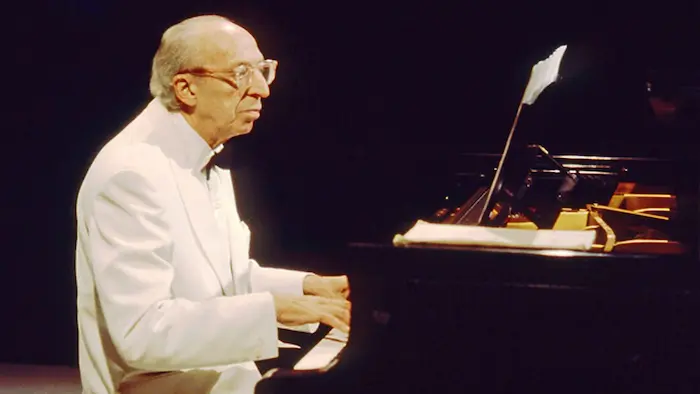Aaron Copland is a seminal figure in American music, renowned for his innovative fusion of classical traditions with American jazz and folk influences. Born in 1900 in Brooklyn, New York, Copland’s music captures the essence of American culture through its integration of diverse musical elements. His compositions reflect a unique blend of classical sophistication and the vibrant rhythms and melodies of American jazz and folk traditions. Copland’s work represents a significant departure from European classical norms, creating a distinctly American sound that continues to influence composers and musicians around the world.
I. Introduction to Aaron Copland
Aaron Copland (1900-1990) is often celebrated as one of America’s greatest composers. He was born in Brooklyn, New York, and his music reflects the rich tapestry of American culture. Copland’s compositions are known for their clarity, simplicity, and incorporation of American folk elements.
Early Life and Education
Aaron Copland was born into a Jewish family with Eastern European roots. His early musical training began with piano lessons, and he showed an early interest in composing.
He studied at the Paris Conservatory under the tutelage of Nadia Boulanger, who had a profound influence on his musical style. During this period, Copland was exposed to a variety of musical influences, including French impressionism and American jazz.
Influence of Jazz and Folk Music
Copland’s music is renowned for its use of American folk melodies and jazz rhythms. He was inspired by the diverse musical landscape of early 20th-century America. His goal was to create a distinctly American sound that reflected the country’s cultural diversity.
II. Copland’s Integration of Jazz and Folk Elements
Copland’s integration of jazz and folk elements into classical music is a hallmark of his style. He achieved this through his innovative use of rhythm, harmony, and orchestration.
Use of Folk Melodies
Copland often incorporated American folk tunes into his compositions. These melodies provided a sense of familiarity and connection to American traditions.
One of his most famous works, Appalachian Spring (1944), features a theme based on the Shaker hymn “Simple Gifts.” This piece highlights how Copland used folk melodies to create a sense of American identity.
Incorporation of Jazz Rhythms
In addition to folk music, Copland also incorporated jazz rhythms into his compositions. His work often features syncopated rhythms and harmonies that reflect the influence of jazz.
For example, in Music for the Theatre (1925), Copland used jazzy rhythms and harmonies to evoke the atmosphere of the American theater. This work is a testament to his ability to blend classical music with jazz elements seamlessly.
III. Key Compositions and Their Jazz-Folk Fusion
Several of Copland’s compositions stand out for their successful fusion of classical music with jazz and folk elements. These works exemplify his innovative approach to composition.
Appalachian Spring (1944)
Appalachian Spring is perhaps Copland’s most famous work. It is a ballet score that captures the spirit of American folk music. The piece is known for its use of Shaker hymns and its clear, accessible style.
The score was originally written for chamber orchestra and later expanded for a larger ensemble. Its distinctive sound features folk melodies and rhythmic patterns that reflect the simplicity and beauty of American rural life.
Rodeo (1942)
Rodeo is another notable work by Copland that incorporates American folk music. This ballet score evokes the spirit of the American West and features lively, folk-inspired melodies.
The ballet includes several well-known pieces, such as “Hoe-Down” and “Ranch House Party.” These sections showcase Copland’s ability to blend folk tunes with classical orchestration.
Billy the Kid (1938)
Billy the Kid is a ballet that tells the story of the famous outlaw. Copland’s score incorporates folk elements and jazz rhythms to evoke the American frontier.
The music captures the rugged and adventurous spirit of the Old West. The ballet’s themes and melodies are infused with American folk traditions and jazz influences.
IV. Copland’s Legacy and Influence
Aaron Copland’s ability to blend classical music with American jazz and folk elements has left a lasting legacy. His compositions are celebrated for their originality and their reflection of American cultural identity.
Impact on American Music
Copland’s work had a profound impact on American music. He helped to define a uniquely American sound that was distinct from European traditions. His use of folk melodies and jazz rhythms paved the way for future generations of American composers.
Influence on Other Composers
Many composers have been influenced by Copland’s approach to blending classical and American musical elements. His innovative use of rhythm, harmony, and melody has inspired a wide range of composers across different genres.
See Also: Exploring Semi-Classical Music: A Fusion of Tradition and Innovation
V. Conclusion
Aaron Copland’s legacy is defined by his exceptional ability to merge classical music with American jazz and folk elements. His compositions, such as Appalachian Spring, Rodeo, and Billy the Kid, showcase his innovative approach to integrating folk melodies and jazz rhythms into classical forms. This synthesis not only defines Copland’s unique sound but also helps to shape American musical identity. His work has left an indelible mark on the music world, inspiring future generations to explore and embrace the rich cultural blend of classical and American musical traditions.

